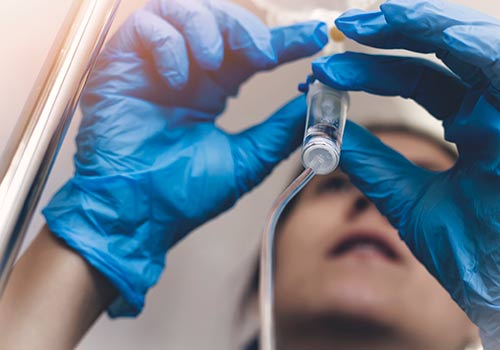Coronavirus disease 2019 (COVID-19) has forced many in the life sciences industry to halt or slow clinical trials — some due to social distancing, others so they can focus on understanding and finding treatments for this new virus. But the need for non-COVID-19 clinical research hasn’t stopped.
Epidemiologists predict more waves of COVID-19 on the horizon. With measures in place to keep people safe from a pandemic, and with the attention of many life sciences organizations turned to COVID-19 therapies, there’s a lot at stake for the broader clinical research field — now and in the future.
Rethinking clinical trial design
Although COVID-19 has catalyzed faster adoption of remote care tools, many have struggled to maintain critical drug development work from a distance. A review of ClinicalTrials.gov by researchers in Berlin shows that more than 2,000 trials have been disrupted by COVID-19.
Patient visits to some hospitals and clinics are down significantly and continued social distancing will likely prevent a regular rhythm of in-person care for months to come. So how can we learn to use distance to our advantage?
Virtual technologies and telehealth tools, like remote patient monitoring and virtual visits, offer a path forward. Certainly, not every study can be done from a distance. But many could be re-designed to include virtual components, limiting patient travel to clinics or hospitals.
-
OR
-
OR
Telehealth gives researchers greater access to patients—whether they are inaccessible due to social distancing or simply because of their location—which could boost enrollments and increase the geographic and socioeconomic diversity of study groups.
The power of real-world data for clinical research
Telehealth and remote patient monitoring aren’t the only tools that could support new thinking around clinical trial design. Real-world data—information about patients’ health that’s routinely collected in claims and electronic health records (EHRs)—can add value to these processes and others.
Real-world data, like that within the Optum Digital Research Network, presents opportunities for accelerating study feasibility analysis and precise patient identification and outreach for clinical trials.
Real-world data is also being used to build synthetic control groups. These digital groups eliminate the need to enroll patients into a control arm, which is particularly helpful for studies focused on rare or fatal diseases, when giving a placebo is not an option. Synthetic control arms work by using data collected from patients already treated per the current standard-of-care — for example during routine clinical care — instead of collecting data from patients newly recruited and randomized into a controlled trial.
AI analysis for drug discovery and post-market surveillance
A mix of artificial intelligence (AI) and traditional analytics is being used to evaluate real-world data and speed up trials targeting a COVID-19 therapeutic. This includes analyses of approved, on-market drugs, like the antiviral remdesivir, for use as COVID-19 treatments.
One-third of drugs never make it past Phase III trials. With one drug taking 10-15 years and upwards of $2 billion to bring to market, the stakes are high, especially those looking for a COVID-19 treatment. AI can mine for new drug targets by simulating different chemical structures and compounds millions of times to find the ones most likely to be useful and can model a drug’s impact on recovery the same way.
Advanced analytics and AI can also enhance post-market surveillance by tracking outcomes and side effects across large populations. Much of the data concerning outcomes or side effects is captured in clinical notes, and until recently was “trapped” within free text fields in EHRs. Reviewing even a fraction of EHRs manually would be impractical and identifying patterns between them nearly impossible for a human to do unassisted by technology. Thanks to natural language processing (NLP) capabilities, AI models can translate that information into discrete data that can be analyzed using machine learning techniques. Once the information is in a structured format, we can begin to understand how a medication is performing in real-time—which opens the door for improved prescribing patterns and increased compliance.
As COVID-19 treatments and vaccines gain approvals, post-market surveillance will play an important role in monitoring public health and safety—and AI will likewise play a critical role, identifying trends within all that data.
Predictive technology for geographical targeting
Life sciences organizations — now, more than ever — need to rely on real-world data and AI technologies to model scenarios and make predictions. Disease-forecasting tools like the Flu Forecast and the Optum COVID-19 dashboard are great examples of this work in progress.
These tools use machine learning to make predictions — down to ZIP code areas — about future waves of disease. Flu Forecast and Optum COVID-19 dashboard are just the beginning of what could become a broader infectious disease early warning platform.
Disease forecasts could help life sciences companies as they plan drug delivery to specific markets. Forecasting can also help with immunization trials, which could be targeted geographically to forecasted hot spots.
Moving forward with a new normal for clinical research
Just as COVID-19 has catalyzed faster telehealth adoption in the care setting, it may also drive demand for emerging and virtual technology for research.
In fact, increased use of telehealth, remote patient monitoring, AI and real-world data for clinical research might help us overcome our current COVID-19-related clinical research obstacles and improve the clinical research process for the future.
It’s fair to say clinical researchers and biotech companies should prepare to be successful in this “new normal."
Cynthia Senerchia, RN, MS, RAC, Vice President, Data Management and Analytics
Cynthia Senerchia, RN, MS, RAC, serves as Vice President, Data Management and Analytics for the Optum Digital Research Network, where she leads the operational processes related to innovative digital trial design using all electronic source data, to feed data bases or study specific electronic data capture (EDC) systems for clinical research.
Peter Payne, Vice President, Head of the Digital Research Network
Peter Payne serves as Vice President, Head of the Digital Research Network, where he leads the strategy and development of this unique integrated network and data platform for the enrollment of patients and conduct of clinical studies using real-world data.
Health analytics and technology innovation
Tag: Emerging Technology, Articles and blogs, Operational Leaders, Executive Insights, Data and analytics, Data & Analytics, Strategy Transformational Leaders, Financial Leaders, Technology Leaders, OptumIQ, Clinical Leaders



